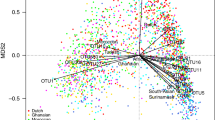Abstract
Colonization of the gut by microbes depends on a number of factors including age, diet, genetic makeup, gender, geographic location, and health status of an individual. India is a megadiverse country and includes 4 biodiversity hot spots. These features, along with the transitioning Indian sociodemographic profile, make the gut microbiota of Indian subjects an interesting area to study. In this review, we critically discuss the present status of the gut microbiome in the Indian population and its difference from other populations. We also discuss the aberrations in the available study designs that could introduce heterogeneity. An ideal study to evaluate the core gut microbiota of healthy Indians should involve a large homogeneous population across the country and use the same technology and data analytics tools. The “Landscape of Gut Microbiome-Pan India Exploration” (LogMPIE) is such a study that confirmed the most predominant organisms in Indians to be Prevotella copri and Faecalibacterium prausnitzii.

Similar content being viewed by others
References
Jandhyala SM, Talukdar R, Subramanyam C, Vuyyuru H, Sasikala M, Nageshwar Reddy D. Role of the normal gut microbiota. World J Gastroenterol. 2015;21:8787-803.
Collado MC, Rautava S, Aakko J, Isolauri E, Salminen S. Human gut colonisation may be initiated in utero by distinct microbial communities in the placenta and amniotic fluid. Sci Rep. 2016;6:23129.
Stinson LF, Boyce MC, Payne MS, Keelan JA. The not-so sterile womb: evidence that the human fetus is exposed to bacteria prior to birth. Front Microbiol. 2019;10:1124.
Lim ES, Rodriguez C, Holtz LR. Amniotic fluid from healthy term pregnancies does not harbor a detectable microbial community. Microbiome. 2018;6:87.
Tito RY, Knights D, Metcalf J, et al. Insights from characterizing extinct human gut microbiomes. PLoS One. 2012;7:e51146.
Chassaing B, Koren O, Goodrich JK, et al. Dietary emulsifiers impact the mouse gut microbiota promoting colitis and metabolic syndrome. Nature. 2015;519:92–6.
Tasnim N, Abulizi N, Pither J, Hart MM, Gibson DL. Linking the gut microbial ecosystem with the environment: does gut health depend on where we live? Front Microbiol. 2017;8:1935.
Hillman ET, Lu H, Yao T, Nakatsu CH. Microbial ecology along the gastrointestinal tract. Microbes Environ. 2017;32:300–13.
Thursby E, Juge N. Introduction to the human gut microbiota. Biochem J. 2017;474:1823–36.
Li J, Jia H, Cai X, et al. An integrated catalog of reference genes in the human gut microbiome. Nat Biotechnol. 2014;32:834–41.
Arumugam M, Raes J, Pelletier E, et al. Enterotypes of the human gut microbiome. Nature. 2011;473:174–80.
https://www.pmfias.com/biodiversity-hotspots-india/ (accessed 10th March 2020).
Pandey PK, Verma P, Kumar H, Bavdekar A, Patole MS, Shouche YS. Comparative analysis of fecal microflora of healthy full-term Indian infants born with different methods of delivery (vaginal vs cesarean): Acinetobacter sp. prevalence in vaginally born infants. J Biosci. 2012;37:989–98.
Harding CM, Hennon SW, Feldman MF. Uncovering the mechanisms of Acinetobacter baumannii virulence. Nat Rev Microbiol. 2018;16:91–102.
Kabeerdoss J, Ferdous S, Balamurugan R, et al. Development of the gut microbiota in southern Indian infants from birth to 6 months: a molecular analysis. J Nutr Sci. 2013;2:e18.
Li M, Wang M, Donovan SM. Early development of the gut microbiome and immune-mediated childhood disorders. Semin Reprod Med. 2014;32:74–86.
Balamurugan R, Janardhan HP, George S, Chittaranjan SP, Ramakrishna BS. Bacterial succession in the colon during childhood and adolescence: molecular studies in a southern Indian village. Am J Clin Nutr. 2008;88:1643–7.
Marathe N, Shetty S, Lanjekar V, Ranade D, Shouche Y. Changes in human gut flora with age: an Indian familial study. BMC Microbiol. 2012;12:222.
Bhute S, Pande P, Shetty SA, et al. Molecular characterization and meta-analysis of gut microbial communities illustrate enrichment of Prevotella and Megasphere in Indian subjects. Front Microbiol. 2016;7:660.
Das B, Ghosh TS, Saxena S, et al. Analysis of the gut microbiome of rural and urban healthy Indians living in sea level and high-altitude areas. Sci Rep. 2018;8:10104.
Dhakan DB, Maji A, Sharma AK, et al. The unique composition of Indian gut microbiome, gene catalogue, and associated fecal metabolome deciphered using multi-omics approaches. Gigascience. 2019;8:giz004.
Dehingia M, Devi KT, Talukdar NC, et al. Gut bacterial diversity of the tribes of India and comparison with the worldwide data. Sci Rep. 2015;5:18563.
Ramadass B, Rani BS, Pugazhendhi S, John KR, Ramakrishna BS. Faecal microbiota of healthy adults in South India: comparison of a tribal & a rural population. Indian J Med Res. 2017;145:237–46.
De Filippis F, Pellegrini N, Laghi L, Gobbetti M, Ercolini D. Unusual sub-genus associations of faecal Prevotella and Bacteroides with specific dietary patterns. Microbiome. 2016;4:57.
Kabeerdoss J, Devi RS, Mary RR, Ramakrishna BS. Faecal microbiota composition in vegetarians: comparison with omnivores in a cohort of young women in southern India. Br J Nutr. 2012;108:953–7.
Dubey AK, Uppadhyaya N, Nilawe P, et al. LogMPIE, pan-India profiling of the human gut microbiome using 16S rRNA sequencing. Sci Data. 2018;5:180232.
Funding
This manuscript has been supported by a Wellcome DBT India Alliance fellowship to Rupjyoti Talukdar (No. IA/CPHS/17/1/503358).
Author information
Authors and Affiliations
Contributions
Priyanjali Pulipati and Priyanka Sarkar—review of the literature and drafting of the manuscript; Aparna Jakkampudi, Vishal Kaila, Subhaleena Sarkar, and Misbah Unnisa—assistance in drafting and revising the manuscript; D. Nageshwar Reddy—provided intellectual inputs; Mojibur Khan—critically reviewed the manuscripts and provided intellectual inputs; Rupjyoti Talukdar—drafted, critically reviewed, and edited the manuscript and gave the final approval.
Corresponding author
Ethics declarations
Conflict of interest
PP, PS, AJ, VK, SS, MU, DNR, MK, and RT declare that they have no conflict of interests.
Disclaimer
The authors are solely responsible for the data and the content of the paper. In no way, the Honorary Editor-in-Chief, Editorial Board Members, or the printer/publishers are responsible for the results/findings and content of this article.
Additional information
Publisher’s note
Springer Nature remains neutral with regard to jurisdictional claims in published maps and institutional affiliations.
Rights and permissions
About this article
Cite this article
Pulipati, P., Sarkar, P., Jakkampudi, A. et al. The Indian gut microbiota—Is it unique?. Indian J Gastroenterol 39, 133–140 (2020). https://doi.org/10.1007/s12664-020-01037-8
Published:
Issue Date:
DOI: https://doi.org/10.1007/s12664-020-01037-8




